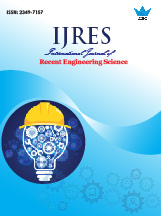Evaluation of Heavy metal contamination in Water, Sediment and Fish (Mystus gulio) from Vattakkayal, a part of Ashtamudi Lake, South India
 |
International Journal of Recent Engineering Science (IJRES) |  |
| © 2015 by IJRES Journal | ||
| Volume-2 Issue-4 |
||
| Year of Publication : 2015 | ||
| Authors : S. Seethal Lal, D.S Jaya, E. Sherly Williams |
||
| DOI : 10.14445/23497157/IJRES-V2I4P103 |
How to Cite?
S. Seethal Lal, D.S Jaya, E. Sherly Williams, "Evaluation of Heavy metal contamination in Water, Sediment and Fish (Mystus gulio) from Vattakkayal, a part of Ashtamudi Lake, South India," International Journal of Recent Engineering Science, vol. 2, no. 4, pp. 10-14, 2015. Crossref, https://doi.org/10.14445/23497157/IJRES-V2I4P103
Abstract
The major objective of the present study is to investigate the accumulation of heavy metals (iron, copper, chromium, cadmium and lead) in water, sediment and in the fish Mystus gulio from Vattakkayal, a part of Astamudi lake, the Ramsar site in Kerala. The results obtained showed that the metals Fe, Cu, and Cr were accumulated in fish at high concentration than those accumulated in water, while the concentration of metals Cd and Pb were recorded low values. Bio-concentration Factor (BCF) of heavy metals in sediments were determined and found that Fe, Cr, Cu and Pb were accumulated at higher concentration than Cd. The concentration of heavy metals in the Vattakkayal exceeds the WHO maximum standard permissible limits. The presence of increased amounts of heavy metals in the water body may have a direct impact on the health of humans as well as aquatic animals. If this lake is not protected from this hazardous situation, the lake as well as the dependent living organisms will be subjected to heavy metal toxicity. Hence it is recommended to implement necessary legislative measures by the authorities to conserve Vattakayal, the part of the Ashtamudi lake, one of the Ramsar sites.
Keywords
Bio-concentration factor, Fish, Heavy metal, Pollution, Vattakkayal
Reference
1. Begum M, Abdullah-Al Mamun, Islam ML & Alam MJ. Morphometric characters and their relationship in estuarine catfish. Journal of Bangladesh Agricultural University 2008; 6(2): 349–353.
2. Stomiñska I, Jezierska B. The effect of Heavy metals on post embryonic development of common carp, Cyprinus carpio L. Archives of Polish Fisheries 2001; 1: 119-128.
3. APHA. Standard Methods for the Examination of Water and Waste water, 22nd Edn., APHA-AWWA-WEF. Washington, DC 2012.
4. Page, A. L.; Miller, R. H. and Kenney, D. R. (1982). Heavy metals determination. In: Methods of Soil Analysis, Part 2, Chemical and Microbiological Properties. American Society of Agronomy, Madison, WI, USA. 8 pp.
5. AOAC (1990). The Association of Official Analytical Chemists. Official Methods of Analysis. 15th Edn. Atomic Absorption Method for Fish. Washington, D.C.
6. Assessment and validation of the CAESAR predictive model for bioconcentration factor (BCF) in fish Lombardo A., Roncaglioni A., Boriani E., Milan C., Benfenati E. Chemistry Central Journal. 2010, 4. (Suppl 1):S1 (29 July 2010).
7. Khalil M, & Faragallah H. The distribution of some leachable and total heavy metals in core sediments of Manzala lagoon, Egypt. Egyptian Journal of Aquatic Research 2008; 34(1): 1-11.
8. World Health Organization (WHO). Guidelines for Drinking Water Quality (Recommendations). WHO, Geneva, 1986; 4: 130.
9. Al-Yousuf MH, El-Shahawi MS, & AL-Ghais SM. Trace metals in liver, skin and muscle of Lethrinus lentjan fish species in relation to body length and sex. Sci Total Environ 2000; 256: 87–94.
10. Dural M, Goksu LM., & Ozak AA. Investigation of heavy metal levels in economically important fish species captured from the Tuzla lagoon. Food Chemistry 2007; 102: 415-421.
11. Usero J, Izquierdo C, Morillo J & Gracia I. Heavy metals in fish (Solea vulgaris, Anguilla Anguilla and Liza aurata) from salt marshes on the southern Atlantic coast of Spain. Environ Int 2003; 29: 949–956.
12. Canli M, Ay O, & Kalay M. Levels of heavy metals (Cd, Pb, Cu, Cr and Ni) in tissues of Cyprinus carpio, Barbus capito and Chondrostoma regium from the Seyhan river, Turkey. Turk J Zoo 1998; 22: 149-157.
13. Karadede H, Oymak SA, Unlu E. Heavy metals in mullet, (Liza abu), and catfish, (Silurus triostegus), from the Ataturk Dam Lake (Euphrates), Turkey. Environ Int 2004; 30(2): 183-188.
14. Yilmaz, B.A. Comparison of Heavy metal levels of grey Mullet (Mugil cephalus) and sea Bream (Sparus aurata) caught in Iskenderun Bay (Turkey). Turk J Vet Anim Sci 2005; 29: 257-262.
15. Yilmaz F, Ozodemir N, Demirak A, Tuna A L. Heavy metal level in two fish species Leuscius cephalus and Lepomis gibbosus. Food Chemistry 2007; 100: 830-835.
16. Azcue J M P, Pfeiffer W C, Donagelo C M., Fiszman M. & Malm, O. Heavy Metals in Foods from the Paraíba do Sul River Valley, Brazil. Journal of Food Composition and Analysis 1988; 1: 250–258.
17. Seethal Lal S, Jaya D S. and Sherly Williams E. Fish faunal Diversity of Vattakkayal, A Part of Ashtamudi Lake, Kollam District, Kerala, South India. International Journal of Scientific and Engineering Research 2013; 4: 418-424.
18. Pelgrom S L, Lamers R, Lock P, Balm and SW Bonga. Integrated physiological response of Tilapia, Orechromis mossambicus, to sublethal copper exposure. Aquat. Toxicol 1995; 32: 303-320.
